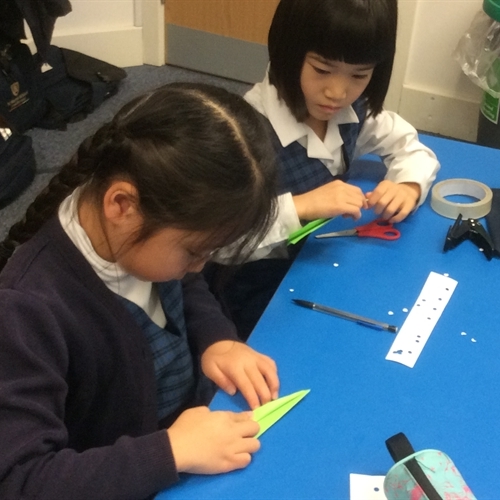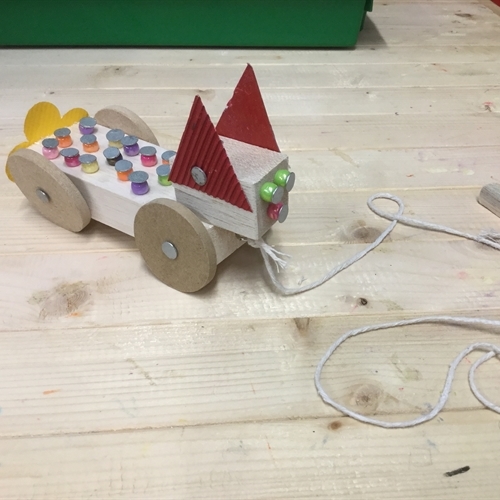STEM: Experimenting in Junior School
What is STEM?
Most people would be able to explain the acronym as representing Science, Technology, Engineering and Mathematics. Most people nowadays can also explain that Science is about observing the world in order to understand how it works, and Mathematics is about understanding how shapes and numbers work.
There is more confusion over Technology and Engineering, as these areas are often misrepresented in general society. However, Technology is about making things and Engineering is about creating solutions to problems.
Our approach to STEM
The way STEM is taught varies widely, with the different strands being taught separately in most educational establishments. In Junior School, our girls acquire subject knowledge in Science and Mathematics in class lessons. However, these disciplines are then made much more meaningful as they are applied along with Technology and Engineering in dedicated STEM lessons.
 In these lessons the girls apply the science learned to solve a problem and then build a solution. The learning experience is further deepened by relating the STEM project to the class topic, if at all possible.
In these lessons the girls apply the science learned to solve a problem and then build a solution. The learning experience is further deepened by relating the STEM project to the class topic, if at all possible.
Our STEM projects
- Learning to fly - Year 2 explored forces, relating to how things fly (both birds and machines). They then designed and built flying machines for a small bear. This was very much related to the class topic, which involved the study of the picture book Leaf, in which a polar bear becomes stranded on a tropical island and attempts to fly home. We then tested the machines. Although the ‘flight’ was not powered, air resistance was used to great effect to slow down the fall!
- Magnetic magic - Year 3 explored forces, but in the context of magnets. They applied their understanding of how magnetic forces work to build magnetic ‘wands’ and characters to move around a theatre. This was also linked to the class topic on the Romans, as the characters the girls designed were involved in Roman myths.
- Going electric -Year 4 studied electricity, and applied their understanding of circuits to design quiz boards based on their topic of South America.
- Clean water - Year 5 used their understanding of materials, specifically dissolving and separating mixtures, to understand the importance of clean water. This was clearly linked to their topic on Africa. We then built working pumps, as these are needed to raise clean water from deep in the ground.
- Industrious minds - Year 6 studied how simple machines work as part of their topic on the Industrial Revolution. They were then able to use gears and pulleys to design and build working cranes.
Mathematical skills are used as part of every project, often without the girls even realising, as they use numbers to count components, shapes to design structures and measuring skills to make sure components are the correct length to fit together.
Another important skill developed through these activities is the ability to work as a team. Girls learn to present their own viewpoint, listen to others and compromise, as they work together to create a solution to the problem.
Reception STEM
Our Reception class is not forgotten! Our youngest students have yet to acquire a large scientific knowledge base, although their understanding of the world develops at an enormous rate.
Reception class STEM lessons are based around woodwork. We teach basic skills of hammering, sawing, screwing and shaping with sandpaper and the girls, with immense creativity, build things. Problems are solved and there are numerous other learning benefits ranging from boosting self-esteem to enhancing communication and social development.
 Lockdown STEM
Lockdown STEM
As I write, we are in lockdown. However, STEM continues! Our online learning provision includes weekly STEM activities, with design and build projects to do at home.
Each week we have explored a theme and a problem for the whole school to consider, with activities suggested at different levels.
Girls have photographed their creations and uploaded them, so we can share each other’s ideas. The first theme was ‘vehicles’, the problem being to transport a toy across the room. Activities range from a basic sledge for the youngest girls to a rubber band powered car for our oldest students.
The challenge has been to create working solutions from the contents of the recycling bin and other easily available household objects. Imagination has no bounds!
Return to Magnolian 2020
STEM in Junior School